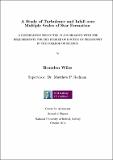| dc.description.abstract | The understanding of the processes of star formation informs the understanding and investigation of questions of galactic dynamics and the formation of stellar systems of exoplanets and so sits between the galactic and solar length scales in terms of astrophysical phenomena.
Low-mass star formation is relatively well-understood in comparison to high-mass star formation. The formation of massive stars is complicated by factors relating to the environment and conditions in which they form: they form in clusters, further away than low mass stars, and remain shrouded in dense natal material longer. The processes surrounding the life and death of massive stars play an important part in the evolution of galaxies at all epochs. At all epochs turbulence in the interstellar medium (ISM) plays a predominant role in regulating massive star formation: principally by supporting cores against collapse. The mechanism by which the material in molecular clouds is triggered to collapse and form stars remains an enigma. Hence, understanding how turbulence shapes star formation, and how star formation in turn contributes to driving interstellar turbulence, is an important step in understanding diverse phenomena such as the evolution of the molecular interstellar medium in galaxies, the formation of massive stars, and, eventually, the role that turbulence may play in the formation of planetary systems.
Mopra molecular line imaging observations of three massive star-forming sources in G333 shows evidence for infall and outflow and observations of the Sagittarius B2 giant molecular clouds suggest new methods of observing these processes on a whole cloud scale. The radiative transfer of the molecular lines is modelled using a 3-D radiative transfer code to extract the infall and outflow signatures from the data.
The findings from these studies presented in this thesis support the idea from the literature that high mass star formation is similar to a scaled up version of low mass star formation, sharing numerous phenomena across length scales such as infall, outflow, and gradients in turbulence and density. This works serves to connect molecular manifestations of massive star formation to smaller scales, seen by Spitzer, and to larger scales mapped by cosmic ray scattering. | en_US |


